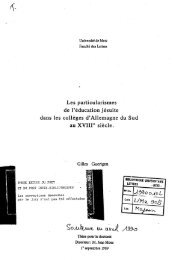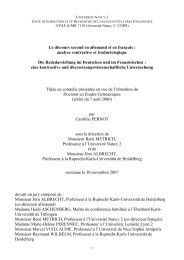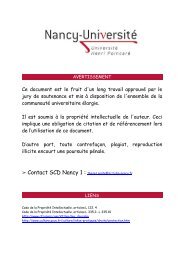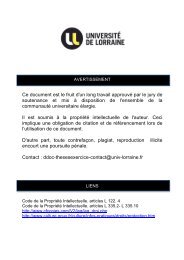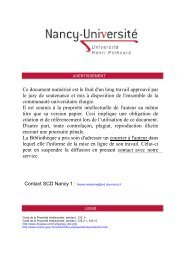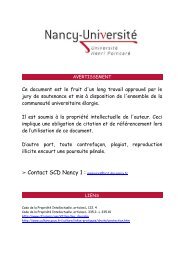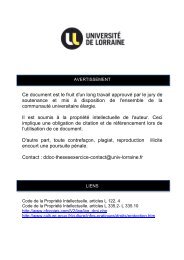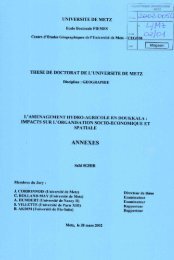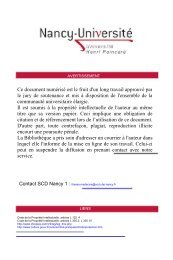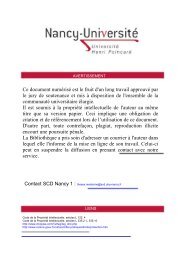1 couverture - Bibliothèques de l'Université de Lorraine
1 couverture - Bibliothèques de l'Université de Lorraine
1 couverture - Bibliothèques de l'Université de Lorraine
You also want an ePaper? Increase the reach of your titles
YUMPU automatically turns print PDFs into web optimized ePapers that Google loves.
cavalier mongol au tableau 15, dont il sera le narrateur. Il racontera à son tour son combat<br />
contre le Géorgien (illustrant le principe <strong>de</strong> divergence <strong>de</strong>s perceptions <strong>de</strong> la réalité).<br />
Le sort réservé aux églises et à leurs précieux livres, tel qu’il est mentionné par l’un<br />
<strong>de</strong>s cavaliers dans le tableau 12 118 est aussi une traduction d’un passage <strong>de</strong> l’History of the<br />
nation of the archers (the Mongols) by Grigor of Akanc’. 119<br />
Le changement <strong>de</strong> cheval opéré par les <strong>de</strong>ux cavaliers, afin que l’homme d’État, dont<br />
la monture est épuisée, puisse échapper à leurs poursuivants, tandis que le plus jeune tombe<br />
prisonnier entre leurs mains 120 est un épiso<strong>de</strong> relaté dans l’History of the nation of the archers<br />
(the Mongols) by Grigor of Akanc’, 121 mais dans un tout autre contexte (la prise <strong>de</strong> Bagdad<br />
par les Mongols), qu’Overhoff a repris pour l’action du tableau 12.<br />
À l’époque <strong>de</strong> la première attaque <strong>de</strong>s Mongols, la Géorgie avait atteint un<br />
épanouissement brillant dans tous les domaines. Cette époque est appelée l’Âge d’or <strong>de</strong> la<br />
Géorgie. 122 « Les rois <strong>de</strong> Géorgie se trouvaient ainsi, au treizième siècle, dominer <strong>de</strong>puis les<br />
bords <strong>de</strong> la mer Noire, entre Trébison<strong>de</strong> et la Crimée, jusqu'au passage <strong>de</strong> Derbend et au<br />
confluent <strong>de</strong> l’Araxe et du Kour, c'est-à-dire sur la Colchi<strong>de</strong>, la Mingrélie, le pays <strong>de</strong>s Abkas,<br />
la Géorgie proprement dite, l’Arménie septentrionale, sans compter plusieurs autres petits<br />
cantons limitrophes. » 123<br />
Le <strong>de</strong>uxième chapitre se clôt par un tableau qui rapproche, <strong>de</strong> façon dramatique, le<br />
lecteur du théâtre <strong>de</strong>s événements. Si jusque-là l’auteur n’avait fait qu’avancer pas à pas vers<br />
la réalité <strong>de</strong>s conquêtes mongoles, il la présente pour la première fois directement aux yeux du<br />
lecteur. Ce tableau est un dialogue d’action – en opposition aux dialogues statiques, comme<br />
celui du premier tableau du premier chapitre –, mettant en scène <strong>de</strong>ux Géorgiens cherchant à<br />
fuir après la bataille sanglante qui a vu la défaite <strong>de</strong> leur armée. Sans qu’aucune indication<br />
118 „Sie plün<strong>de</strong>rten die Kirchen und warfen die schön geschmückten, goldverzierten Bücher als unnütz in <strong>de</strong>n<br />
Kot.“ (Le Mon<strong>de</strong> avec Gengis Khan, p. 148).<br />
119 “[…] and plun<strong>de</strong>ring the churches of the Christians without fear. Stripping the precious relics of the holy<br />
and the crosses and holy books of their ornaments, they cast them away as of no value.” (History of<br />
the nation of the archers (the Mongols) by Grigor of Akanc’. Hitherto ascribed to Magak’ia the monk. The<br />
armenian text edited with an english translation and notes by Robert P. Blake and Richard N. Frye, Cambridge,<br />
1954, p. 305).<br />
120 Le Mon<strong>de</strong> avec Gengis Khan, pp. 152-153.<br />
121 “The Tat’ars, observing their flight, pursued them at full gallop. Now P’ntuxtar was bear<strong>de</strong>d and had a poor<br />
horse, but Sγur was a stripling and had a fine horse. When they realized it was the intention of the Tat’ars to<br />
seize them both, Sγur dismounted from his Arab steed, gave it to P’ntuxtar, and himself mounted the poor horse.<br />
He said to P’ntuxtar, “Mount thou the good horse and flee. I am a stripling, and if the Tat’ars catch me they will<br />
not kill me, but will take me away as a captive. When you find any way, ransom me.” (History of the nation of<br />
the archers (the Mongols) by Grigor of Akanc’. Hitherto ascribed to Magak’ia the monk. The armenian text<br />
edited with an english translation and notes by Robert P. Blake and Richard N. Frye, Cambridge, 1954, p. 355).<br />
122 Cf. Nodar Assatiani/Alexandre Bendianachvili : Histoire <strong>de</strong> la Géorgie, Paris, 1997, p. 154.<br />
123 François René Rohrbacher : Histoire universelle <strong>de</strong> l’église catholique, vol. 17, Paris, 1858, p. 647.<br />
213



